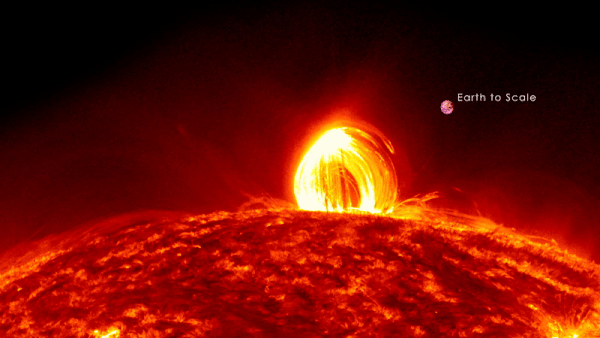

Doctoral candidate Emily Mason took a leap of faith by going back to school to pursue her Ph.D. in physics after working various jobs. She couldn’t look away from her interest in analyzing data and her love of astronomy and space science.
Recently, Mason has made some breakthrough discoveries.
As Mason was observing coronal rain, she found smaller structures which ended up showing a link between why the sun’s outer atmosphere, called the corona, is hotter than the sun’s surface and the source for slow solar wind, both of which are solar science mysteries.
According to Mason’s research at NASA, coronal rain is made up of plasma (electrically charged gas) that creates a magnetic loop that extends from the sun’s surface, where the plasma gets super heated. As the plasma reaches its peak, it cools and gravity pulls it down creating a blob known as coronal rain.
“Funnily enough, originally I didn't pay much attention to it. I had started out looking for coronal rain in much bigger structures (helmet streamers), so when I found it in these small structures I sidelined them. It was one of my mentors at NASA, Nicholeen Viall, who realized I had found something other observers had overlooked. Once she impressed this on me, it became very exciting!”
Mason has worked at NASA Goddard as a graduate researcher since the fall of 2016. NASA’s Solar Dynamic Observatory uses high-resolution telescopes which shows similarities with the sun and earth.
Researchers, including Mason, have been searching for coronal rain in helmet streamers, due to it’s heating and cooling cycle. Helmet streamers are known as being one source of slow solar wind, a slow stream of gas that escapes the sun. Research has shown that slow solar wind has been heated and cooled before escaping the sun, similar to the process of coronal rain.
Coronal rain commonly forms when heat is applied to the bottom of the loop. This fact is a step toward the mystery of why and how the sun’s atmosphere is 300 times hotter than the sun’s surface.
The smaller structures or loops that Mason found don’t indicate exactly how the sun’s atmosphere is heated but they do reveal that it is happening in the small structure layer. Mason’s findings may also explain an alternative source of solar wind. She found that coronal rain was forming on open magnetic field lines that go out into space forming solar wind. Whereas scientists only saw coronal rain forming on closed loops where the plasma couldn’t escape. Since these findings, Mason and the NASA team have developed an alternative explanation that connects the rain to the small magnetic structures to slow solar wind in The Astrophysical Journal Letters.
Mason says, “I’m most excited about testing our hypothesis on how the rain forms. There are several known mechanisms to form coronal rain, but in this paper we posited a new formation mechanism. The next step is to run some computer simulations and see if we can make rain using the new mechanism — there’s lots of impatiently waiting for code to finish in my near future!
“Goddard is an incredible place; there are world-class experts lining every hallway, and they're friendly and eager to help students excel. You get to work on real, significant science problems from day one, and your mentors and supervisors will treat you with respect as a person and a scientist. There are so many resources and events that advance research and promote scientific collaboration — it's basically science heaven.”